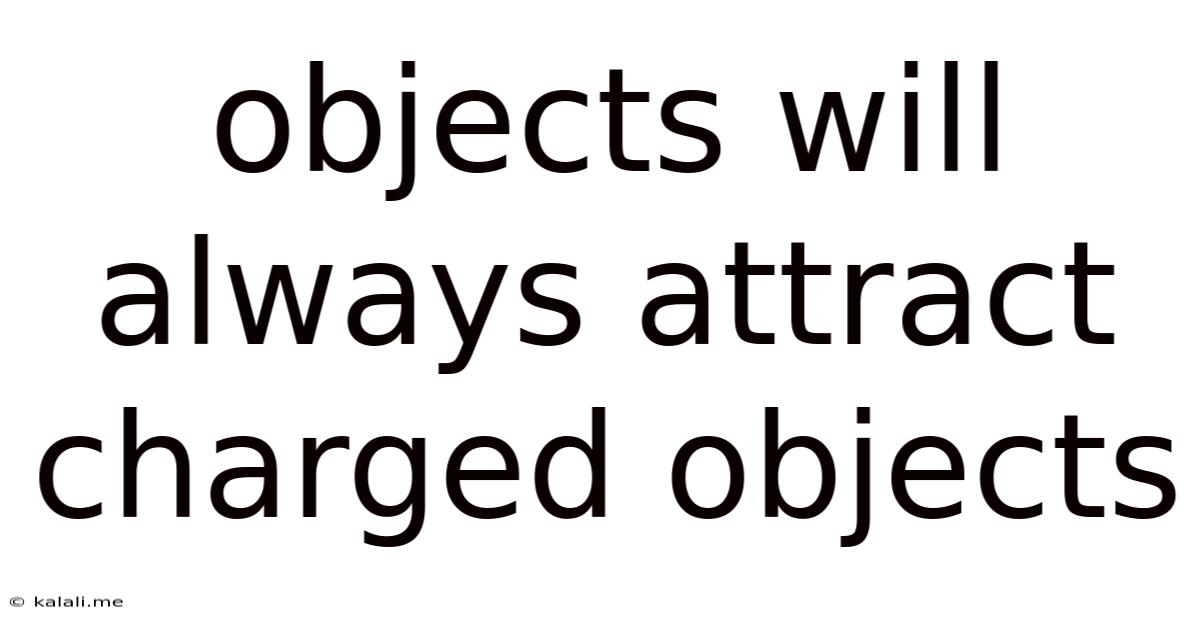Objects Will Always Attract Charged Objects
Kalali
Jun 10, 2025 · 3 min read

Table of Contents
Objects Will Always Attract Charged Objects: Understanding Electrostatic Attraction
Meta Description: Discover the fundamental principles of electrostatic attraction, exploring why uncharged objects are always attracted to charged objects, and delve into the science behind this ubiquitous phenomenon. We'll explore the mechanisms involved, including induction and polarization, and provide real-world examples.
Have you ever noticed how a balloon, after being rubbed against your hair, suddenly sticks to a wall? Or how dust particles seem magnetically drawn to your TV screen? This isn't magic; it's the fascinating world of electrostatic attraction. Contrary to what you might initially think, even uncharged objects will always attract charged objects. This article will explain why.
The Basics of Electric Charge
Before delving into the attraction itself, we need to understand the basics. Matter is made up of atoms, which contain positively charged protons, negatively charged electrons, and neutral neutrons. An object becomes electrically charged when it has an imbalance of these charges – either an excess of electrons (giving it a negative charge) or a deficiency of electrons (giving it a positive charge).
Induction and Polarization: The Key Players
The attraction between a charged object and an uncharged object isn't because the uncharged object suddenly gains a charge. Instead, it's due to a process called polarization. When a charged object (let's say, negatively charged) approaches an uncharged object, it influences the distribution of charges within the uncharged object.
The negatively charged object repels the electrons in the uncharged object, causing them to shift slightly to the opposite side. This leaves a net positive charge on the side closest to the charged object. Because opposite charges attract, the positive side of the uncharged object is drawn towards the negatively charged object, resulting in attraction. This shifting of charges is called charge induction.
This phenomenon is not limited to negative charges. A positively charged object will similarly induce a negative charge on the nearest side of an uncharged object, leading to attraction. This explains why an uncharged object is always attracted to a charged object, regardless of the charge's polarity.
Real-World Examples of Electrostatic Attraction
This principle is at play in many everyday occurrences:
- Static cling: Clothes sticking together after being tumble-dried is a classic example of electrostatic attraction.
- Dust on screens: The static charge on your TV or computer screen attracts dust particles.
- Lightning rods: These protect buildings from lightning strikes by attracting the charge to a grounded conductor.
- Inkjet printers: Tiny charged ink droplets are attracted to the paper to form the printed image.
Understanding the Strength of Attraction
The strength of the electrostatic attraction depends on several factors:
- Magnitude of the charge: A larger charge results in a stronger attraction.
- Distance between objects: Attraction decreases rapidly with increasing distance.
- Material properties: The ease with which charges can move within an object (its conductivity) influences the degree of polarization and therefore the attraction.
Conclusion: A Universal Force
Electrostatic attraction, driven by the principles of induction and polarization, is a fundamental force in nature. It explains why even uncharged objects are always drawn to charged objects, a phenomenon that's both common and crucial in many aspects of our lives, from the annoying static cling in our laundry to the sophisticated workings of modern technology. Understanding this basic principle opens a window into the complex and fascinating world of electromagnetism.
Latest Posts
Latest Posts
-
How Many Cups In A Pound Of Hamburger Meat
Jul 02, 2025
-
Imagery Or Figurative Language From Romeo And Juliet
Jul 02, 2025
-
What Is A Quarter Of A Million
Jul 02, 2025
-
Which Of The Following Is True Concerning A Dao
Jul 02, 2025
-
How Long Can Catfish Live Out Of Water
Jul 02, 2025
Related Post
Thank you for visiting our website which covers about Objects Will Always Attract Charged Objects . We hope the information provided has been useful to you. Feel free to contact us if you have any questions or need further assistance. See you next time and don't miss to bookmark.